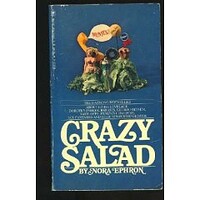Status
Available
Publication
Bantam (1976), 208 pages
Description
A glimpse into the absurdities and realities of female existence in the early 1970s discusses the media, politics, the first female umpire, and beauty products.
User reviews
LibraryThing member hikatie
Somehow 1972 seems so long ago. Nora Ephron's essays are funny and sharp, but so many of them seem to somehow read as oddly-ancient history, particularly the daily practicalities and impracticalities of being a feminist (or Women's Lib-er, really) in New York.
LibraryThing member kristenn
I was inspired to read this by Ariel Levy's recent New Yorker profile on Ephron. These pieces have much more substance than her movies, or even her most recent book. Most of these essays were written just after I was born, so it's a useful historical perspective. A lot actually has improved. My
Show More
copy is full of little post-it flags for things I will have to look up, or ask my mother about. On the other hand, probably none of the book's original readers knew why a Pillsbury Bake-Off contestant's speedy Hawaiian bread was called Wiki Coffee Cake... Show Less
LibraryThing member michaelm42071
Twenty-five pieces written from 1972 to 1974 and published in Esquire, New York Magazine, and Rolling Stone. Ephron discusses her problem with being a journalist and a feminist. If she writes about an aspect of the women’s movement—consciousness-raising is an example—and finds it humorous, it
The first three pieces, including “A Few Words About Breasts,” establish her as someone who, as tomboy, late bloomer, very intelligent youngster and very humorous observer, already was at odds with the stereotypes of glamor girl or domestic goddess long before she encountered the women’s movement. She casts a withering eye on subjects such as feminine deodorant spray, the Pillsbury Bake-Off, and Julie Nixon as apologist for her father. She covers a feud between Betty Friedan and Gloria Steinem at the 1972 Democratic Convention and George McGovern’s betrayal of his supporters in the women’s movement in what must be the most futile political sellout ever. Although in profound sympathy with the goals of the women’s movement, she is horrified at some of its more bizarre manifestations such as do-it-yourself abortion (as is Ellen Frankfort, whose book Vaginal Politics Ephron reviews) and she is amused at others. She reviews The Girls in the Office, transcripts of tape recordings of fifteen single women working in a New York office: “life imitating trash.” She writes with a seemingly straight face about Linda Lovelace of Deep Throat notoriety, political wives, and the Bobby Riggs-Margaret Court tennis match. In the last piece she slams Jan Morris’s book Conundrum, about her sex change, calling the book mawkish. On James Morris’s always wanting to be a girl, she says “I always wanted to be a girl, too.” The trouble is that Jan Morris has become, not a woman, but a girl.
Show More
seems as if she’s letting down the side. But she finds humor in almost everything. And if she criticizes a book whose premise she heartily agrees with—the example here is Phyllis Chesler’s Women and Madness—her pointing out that it is badly written and researched as well as self-indulgent “will hurt the book politically.”The first three pieces, including “A Few Words About Breasts,” establish her as someone who, as tomboy, late bloomer, very intelligent youngster and very humorous observer, already was at odds with the stereotypes of glamor girl or domestic goddess long before she encountered the women’s movement. She casts a withering eye on subjects such as feminine deodorant spray, the Pillsbury Bake-Off, and Julie Nixon as apologist for her father. She covers a feud between Betty Friedan and Gloria Steinem at the 1972 Democratic Convention and George McGovern’s betrayal of his supporters in the women’s movement in what must be the most futile political sellout ever. Although in profound sympathy with the goals of the women’s movement, she is horrified at some of its more bizarre manifestations such as do-it-yourself abortion (as is Ellen Frankfort, whose book Vaginal Politics Ephron reviews) and she is amused at others. She reviews The Girls in the Office, transcripts of tape recordings of fifteen single women working in a New York office: “life imitating trash.” She writes with a seemingly straight face about Linda Lovelace of Deep Throat notoriety, political wives, and the Bobby Riggs-Margaret Court tennis match. In the last piece she slams Jan Morris’s book Conundrum, about her sex change, calling the book mawkish. On James Morris’s always wanting to be a girl, she says “I always wanted to be a girl, too.” The trouble is that Jan Morris has become, not a woman, but a girl.
Show Less
Subjects
Language
Original publication date
1975
Physical description
208 p.
ISBN
055312496X / 9780553124965
Local notes
essays
